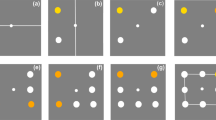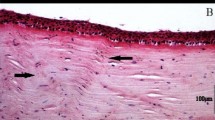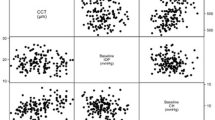Abstract
Purpose To evaluate corneal topographic features and tear secretion in eyes with the Hudson–Stahli line.
Methods Keratometry, computerized videokeratography and Schirmer testing were performed in 50 cases with bilateral Hudson–Stahli line, and 55 controls without the Hudson–Stahli line. Similar tests were performed in 21 subjects with unilateral Hudson–Stahli line.
Results Corneal topographic features and keratometry in the horizontal meridian were similar in cases and controls, and in fellow eyes of subjects with unilateral Hudson–Stahli line. Keratometry in the vertical meridian in cases (43.01 ± 2.01) was significantly lesser than in controls (43.94 ± 1.77) (P = 0.01). This value was not different in fellow eyes of patients with unilateral Hudson–Stahli line. Schirmer testing revealed significantly greater tear secretion in cases (16.72 ± 4.99 mm) compared to controls (12.57 ± 3.62 mm) (P < 0.01). In subjects with unilateral Hudson–Stahli line, mean Schirmer values in the eye with the line (17.52 ± 6.86 mm) were significantly greater than in eyes without (13.67 ± 4.64 mm) (P = 0.04).
Conclusion Formation of the Hudson–Stahli line may be dependent on the presence of normal tear secretion in the eye.
Similar content being viewed by others
Log in or create a free account to read this content
Gain free access to this article, as well as selected content from this journal and more on nature.com
or
References
Rose GE, Lavin MJ . The Hudson–Stahli line III: Observations on morphology, a critical review of etiology and a unified theory for the formation of iron line of the corneal epithelium. Eye 1987; 1: 475–479
Gass JD . The iron lines of the superficial cornea: Hudson–Stahli line, Stocker’s line and Fleischer’s ring. Arch Ophthalmol 1964; 71: 348–358
Mannis MJ . Iron deposition in the corneal graft—another corneal iron line. Arch Ophthalmol 1983; 101: 1858–1861
Steinberg EB, Wilson LA, Waring GO III, Lynn MJ, Coles WH . Stellate lines in the corneal epithelium after radial keratotomy. Am J Ophthalmol 1984; 98: 416–421
Assil KA, Quantock AJ, Barrett AM, Schanzlin DJ . Corneal iron lines associated with the intrastromal corneal ring. Am J Ophthalmol 1993; 116: 350–356
Ozdamar A, Aras C, Sener B, Karacorlu M . Corneal iron ring after hyperopic laser-assisted in situ keratomileusis. Cornea 1999; 18: 243–245
Bogan SJ, Waring GO III, Ibrahim O, Drews C, Curtis L . Classification of normal corneal topography based on computer-assisted videokeratography. Arch Ophthalmol 1990; 108: 945–949
Barraquer-Somers E, Chan CC, Green RW . Corneal epithelial iron deposition. Ophthalmology 1983; 90: 729–734
Koenig SB, McDonald MB, Yamaguchi T, Friedlander M, Ishii Y . Corneal iron lines after refractive keratoplasty. Arch Ophthalmol 1983; 101: 1862–1865
Rose GE, Lavin MJ . The Hudson–Stahli line I: an epidemiological study. Eye 1987; 1: 466–470
Hanna C, O’Brien JE . Cell production and migration in the epithelial layer of the cornea. Arch Ophthalmol 1960; 64: 536–539
Iwamoto T, De Voe AG . Electron microscopical study of the Fleischer ring. Arch Ophthalmol 1976; 94: 1979–1984
Norn MS . Hudson–Stahli’s line of cornea. I. Incidence and morphology. Acta Ophthalmol 1968; 46: 106–118
Norn M . Hudson–Stahli’s iron line in the cornea. Occurrence in 1968 and 1988. Acta Ophthalmol (Copenh) 1990; 68: 339–340
Jordan A, Baum J . Basic tear flow: does it exist?. Ophthalmology 1980; 87: 920–930
Mathers WD, Lane JA, Zimmerman WB . Tear film changes associated with normal aging. Cornea 1996; 15: 229–234
Author information
Authors and Affiliations
Corresponding author
Rights and permissions
About this article
Cite this article
Rao, S., Ananth, V. & Padmanabhan, P. Corneal topography and Schirmer testing in eyes with the Hudson–Stahli line. Eye 16, 267–270 (2002). https://doi.org/10.1038/sj.eye.6700028
Published:
Issue date:
DOI: https://doi.org/10.1038/sj.eye.6700028



